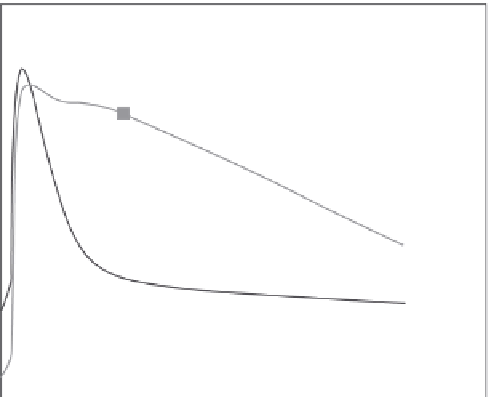Biomedical Engineering Reference
In-Depth Information
CNTs showed a uniform dispersion in the copolymer matrix, whereas severe agglomeration
occurred at 5 wt % CNTs due to CNT entanglement and resulted in high porosity. The mechanical
properties of PLC composite with 2 wt % CNTs increased remarkably, and an increase in elastic
modulus by 100% and tensile strength by 160% were detected without any adverse effect on the
ductility of PLC up to 240% elongation. An in vitro biocompatibility study on the PLC
CNT com-
posites showed an increase in the viability of human osteoblast cells compared with the PLC
matrix, which was attributed to the combined effect of CNT content and surface roughness of the
composite films. Mattioli-Belmonte et al.
[23]
reported the mechanical, thermal, and biological
characterization of a solid free form microfabricated polycaprolactone (PCL)
CNT composite. By
changing the ratio of CNTs to PCL, the elastic modulus of the nanocomposites varied between
10 MPa and 75 MPa (
Figure 18.2
). When the CNT concentration in the composite reached 12.5 mg/ml,
the elastic modulus achieved the maximum point. If CNT concentrations were high, their inhomo-
geneous dispersion in the composite materials would lead to an abrupt decrease of elastic modulus
as well as an increase in fragility. Pan et al.
[24]
fabricated MWCNT/PCL composite scaffolds by
the solution evaporation technique. Their results also showed that mechanical properties of the
composite scaffolds were improved with the addition of MWCNTs (0.25
2 wt %).
Sitharaman et al.
[25]
examined the suitability of various nanocomposite materials made of
poly(propylene fumarate) (PPF) and SWCNT for potential use as bone tissue engineering scaffolds.
They demonstrated that SWCNTs, especially ultra-short SWCNTs (US-tube), could significantly
90
PCL1
PCL2
80
B
70
B
C
D
60
50
C
40
E
D
30
A
E
20
10
A
0
0
50
100
150
200
250
300
CNT concentration (mg/mL)
FIGURE 18.2
Elastic modulus of composite spin coated films as function of CNT concentration. The errors are of the order
of 4%. The PCL (MW65,000) polymer was dissolved in chloroform to give 0.1 g/ml and 0.2 g/ml solutions
(w/v), referred to as solutions PCL1 and PCL2, respectively.
Reproduced with permission from Ref.
[23]
.


































































